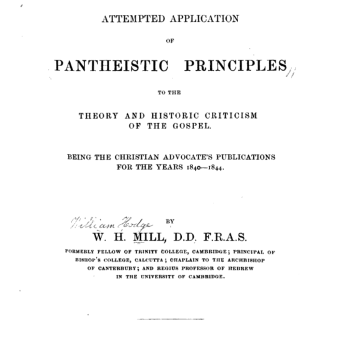Doubting Jesus’ Sanity? / Inconsiderate (?) Young Jesus in the Temple / “Woman” and the Wedding at Cana

Jason Engwer is a Protestant apologist who is also an anti-Catholic polemicist (as presently). This is a response to his article, “Some Early Sources On The Sinlessness Of Mary” (9-7-06). His words will be in blue.
*****
The Biblical view of Mary seems to be that she was a believer who sometimes sinned. Like John the Baptist, Peter, and other New Testament figures, she’s sometimes an example of faithfulness to God and sometimes an example of how “we all stumble in many ways” (James 3:2). The belief that Mary was a sinner apparently goes back to scripture itself, . . .
It’s not the biblical view — I would contend — once the full implication of Luke 1:28 (Hail Mary, full of grace”) is understood. I have made an entirely biblical argument for Mary’s sinlessness based on that passage and other ones related to grace and its antithetical relation to sin in the New Testament:
Luke 1:28 (“Full of Grace”) & Immaculate Conception [2004]
Dialogue: Luke 1:28 & Immaculate Conception [7-11-06]
The Bible: Mary Was Without Sin [4-1-09]
Mary’s Immaculate Conception: A Biblical Argument [2010]
Annunciation: Was Mary Already Sublimely Graced? [10-8-11]
Sinless Mary: Dialogue w OT Professor (Dr. Jonathan Huddleston) [12-8-14]
“Armstrong vs. Geisler” #6: Sinless Mary [3-1-17]
Scripture, Through an Angel, Reveals That Mary Was Sinless [National Catholic Register, 4-30-17]
Biblical Support for Mary’s Immaculate Conception [National Catholic Register, 10-29-18]
I should also note that the passages discussed below are representative examples. Other relevant passages from the New Testament and the ante-Nicene sources could be cited.
In the gospels, Mary is often associated with Jesus’ unbelieving brothers, not just in terms of being with them, but also in terms of joining them in their opposition to Jesus:
“Not only the religious leaders ([Matthew] 12:24, 38), but Jesus’ own family doubted him (Mk 3:21-31, bracketing the Pharisees’ attack; cf. Jn 7:5)….Relatives normally sought to conceal other relatives’ behavior that would shame the whole family, hence their concern in Mark 3:20-21 (cf. Malina 1993: 80). Their opposition to or disbelief in Jesus is less clear in Matthew than in Mark, perhaps because of the shame of the family’s unbelief, especially after Mary’s experiences in Matthew’s infancy narratives” (Craig Keener, A Commentary On The Gospel Of Matthew [Grand Rapids, Michigan: William B. Eerdmans Publishing Company, 1999], pp. 369-370)
I have dealt with this false claim many times:
“Who is My Mother?”: Beginning of “Familial Church” [8-26-19]
“Who is My Mother?” — Jesus and the “Familial Church” [National Catholic Register, 1-21-20]
Jesus’ “Brothers” Were “Unbelievers”? (Jason also claims that “Mary believed in Jesus,” but wavered, and had a “sort of inconsistent faith”) (vs. Jason Engwer) [5-27-20]
Dialogue on Whether Jesus’ Kinfolk Were “Unbelievers” (vs. Dr. Lydia McGrew) [5-28-20]
On Whether Jesus’ “Brothers” Were “Unbelievers” [National Catholic Register, 6-11-20]
Did the Blessed Virgin Mary Think Jesus Was Nuts? [7-2-20]
Here is the heart of my argument in my article dated 7-2-20 above:
***
Mark 3:21-22 (RSV) And when his family heard it, they went out to seize him, for people were saying, “He is beside himself.” [22] And the scribes who came down from Jerusalem said, “He is possessed by Be-el’zebul, and by the prince of demons he casts out the demons.” (cf. Jn 10:20-21)
Note the italicized and bolded word. Other translations (including, unfortunately, KJV, NKJV, NIV, NASB) make it sound like Jesus’ family were agreeing and/or saying that Jesus’ was mad, but in fact the text is saying that “people” in general were doing so (just as the Pharisees did).
But if the text doesn’t refer to them, it can simply be construed as His family coming out to remove Him from the crowds, who were massively misunderstanding Him, accusing, and perhaps becoming violent (as at Nazareth, when they tried to throw Him over a cliff). Hence, there would be no necessary implication of His family’s (let alone Mary’s) disbelief in Him. They were concerned for His safety. Other translations convey the true sense of the passage (which is interpreted by 3:22 indicating that the “scribes” were saying Jesus was crazy):
NRSV When his family heard it, they went out to restrain him, for people were saying, “He has gone out of his mind.”
Good News / (TEV) When his family heard about it, they set out to take charge of him, because people were saying, “He’s gone mad!”
Moffatt . . . . . . for men were saying, “He is out of his mind.”
Phillips . . . for people were saying, “He must be mad!”
NEB . . . for people were saying that he was out of his mind.
Even in the translation that has “they were saying.” etc., it’s a question of who “they” refers to. It can still be read as others besides the family. The 1953 Catholic Commentary, edited by Dom Bernard Orchard, has some very good commentary on the passage:
The usual interpretation is that relatives (or followers) of Christ, disturbed by reports, came out to take charge of him. The following points are to be noted. (1) The phrase οἱ παρ’αὐτοῦ does not necessarily mean relatives (friends). It has a wider usage which would include disciples, followers, members of a household. It is not certain that the persons designated by this phrase are the same as ‘his mother and brethren’, 31. Even if they are, there is no reason for thinking that our Lady shared in the sentiments of the others, though she would naturally wish to be present when the welfare of her divine Son was in question. (2) ‘For they said’, rather, ‘For people were saying’. If this be correct, then 21b refers to reports which reached Christ’s friends, not to an expression of opinion by them.
***
Suffice it to say that there is no direct evidence that Mary thought her son was out of his mind. It appears to be applied to the passage because of a bias or predisposition (which is eisegesis), as opposed to the idea actually being present in the passage.
A group of some of the leading Catholic and Lutheran scholars in the world, while addressing Luke 2:48-50, commented that “Mary’s complaining question in v. 48 seems to be a reproach to Jesus” (Raymond Brown, et al., editors, Mary In The New Testament [Mahwah: Paulist Press, 1978], p. 160). Darrell Bock writes:
“Mary, speaking for both parents, wants to know why he [Jesus] has done such a seemingly insensitive thing. Jesus’ reply in the next verse addresses both of them as well. The form of Mary’s question may have OT roots (Gen. 20:9; 12:18; 26:10; Exod. 14:11; Num. 23:11; Judg. 15:11). This is the language of complaint….Bovon 1989: 159 notes that the idiom suggests the questioner’s [Mary’s] belief that an error has been made.” (Luke, Volume 1, 1:1-9:50 [Grand Rapids, Michigan: Baker Books, 1994], p. 268 and n. 18 on p. 268)
Luke 2:42-50 And when he was twelve years old, they went up according to custom; [43] and when the feast was ended, as they were returning, the boy Jesus stayed behind in Jerusalem. His parents did not know it, [44] but supposing him to be in the company they went a day’s journey, and they sought him among their kinsfolk and acquaintances; [45] and when they did not find him, they returned to Jerusalem, seeking him. [46] After three days they found him in the temple, sitting among the teachers, listening to them and asking them questions; [47] and all who heard him were amazed at his understanding and his answers. [48] And when they saw him they were astonished; and his mother said to him, “Son, why have you treated us so? Behold, your father and I have been looking for you anxiously.” [49] And he said to them, “How is it that you sought me? Did you not know that I must be in my Father’s house?” [50] And they did not understand the saying which he spoke to them.
I don’t think “why have you treated us so?” is necessarily (wholly apart from theology and viewed logically and grammatically) an accusation of sinfulness on Jesus’ part at all. Mary and Joseph were simply (undeniably) perplexed, but it doesn’t follow that they were therefore accusing Jesus of sin. After all, all Christians believe that God is sinless, yet we are often perplexed by His words or actions or lack of answers to prayers, etc. None of that automatically means that we accuse God of sin.
We’re simply confused and lacking answers and full knowledge, while we accept certain mysteries in faith and the fact that God’s ways are much higher than ours. So they asked, “why have you treated us so?” They didn’t understand. And I’m sure they would have been the first to admit that they wouldn’t always fully understand God the Son.
The 1953 Catholic Commentary, edited by Dom Bernard Orchard, noted:
Mary and Joseph are also amazed. . . but Lk gives the reason in 48b: Jesus has never behaved so to Mary before. It is to be remembered that with her, as with others, Jesus had conducted himself as a normal child; his divinity was to her, as to us, an object of faith and not vision. . . . 51b also throws light on the point. ‘They learnt only gradually what his Messiahship involved (cf. 2:34–35) and this is one stage in the process. From the point of view of her subsequent knowledge, Mary recognized that she and Joseph had not understood’ (Plummer ICC on 2:51).
Pope St. John Paul II offers further explanation:
Several early Fathers of the Church, who were not yet convinced of her perfect holiness, attributed imperfections or moral defects to Mary. Some recent authors have taken the same position. However, the Gospel texts cited to justify these opinions provide no basis at all for attributing a sin or even a moral imperfection to the Mother of the Redeemer.
Jesus’s reply to his mother at the age of 12: “How is it that you sought me? Did you not know that I must be in my Father’s house?” (Lk 2:49), has sometimes been interpreted as a veiled rebuke. A careful reading of the episode, however, shows that Jesus did not rebuke his mother and Joseph for seeking him, since they were responsible for looking after him.
Coming upon Jesus after an anxious search, Mary asked him only the “why” of his behaviour: “Son, why have you treated us so?” (Lk 2:48). And Jesus answers with another “why”, refraining from any rebuke and referring to the mystery of his divine sonship. (“Mary Was Free from All Personal Sin,” 6-26-96)
Regarding John 2:4, Craig Keener writes:
“Jesus’ answer in v. 4 is a rebuff, but like the rebuff of 4:48, is more a complaint than an assertion that he will not act….Jesus is establishing a degree of distance between himself and his mother, as did the Jesus of the Synoptic tradition….The rebuff element is increased in Jesus’ next words [‘What is there between us?’], however. In both OT and Gospel tradition (e.g., Mark 1:24; Luke 4:34), as well as Greco-Roman idiom, a phrase like ‘What is there between us?’ would imply distancing or hostility….But the primary reason for the rebuff must be that his mother does not understand what this sign will cost Jesus: it starts him on the road to his hour, the cross.” (The Gospel Of John: A Commentary, Vol. 1 [Peabody, Massachusetts: Hendrickson Publishers, 2003], pp. 504-506)
John 2:3-4 When the wine failed, the mother of Jesus said to him, “They have no wine.” [4] And Jesus said to her, “O woman, what have you to do with me? My hour has not yet come.”
I dealt with this false claim that Jesus was rebuking His mother, who supposedly sinned, in my article dated 7-2-20:
***
The next misguided criticism is directed towards the wedding of Cana: the old, tired, fundamentally silly argument that Jesus was supposedly disrespectful of His mother. This silly trifle was disposed of by Catholic apologist Jimmy Akin, citing three Protestant commentators:
The Protestant commentator William Barclay writes:
“The word Woman (gynai) is also misleading. It sounds to us very rough and abrupt. But it is the same word as Jesus used on the Cross to address Mary as he left her to the care of John (John 19:26). In Homer it is the title by which Odysseus addresses Penelope, his well-loved wife. It is the title by which Augustus, the Roman Emperor, addressed Cleopatra, the famous Egyptian queen. So far from being a rough and discourteous way of address, it was a title of respect. We have no way of speaking in English which exactly renders it; but it is better to translate it Lady which gives at least the courtesy in it” (The Gospel of John, revised edition, vol. 1, p. 98).
Similarly, the Protestant Expositor’s Bible Commentary, published by Zondervan, states:
Jesus’ reply to Mary was not so abrupt as it seems. ‘Woman’ (gynai) was a polite form of address. Jesus used it when he spoke to his mother from the cross (19:26) and also when he spoke to Mary Magdalene after the Resurrection (20:15)” (vol. 9, p. 42).
Even the Fundamentalist Wycliff Bible Commentary put out by Moody Press acknowledges in its comment on this verse, “In his reply, the use of ‘Woman’ does not involve disrespect (cf. 19:26)” (p. 1076).
Did Jesus “rebuke” His mother at this wedding? No: . . . The Navarre Bible explains the passage:
[The sentence rendered “What have you to do with me?” (RSV) is the subject of a note in RSVCE which says “while this expression always implies a divergence of view, the precise meaning is to be determined by the context, which here shows that it is not an unqualified rebuttal, still less a rebuke.” The Navarre Spanish is the equivalent of “What has it to do with you and me?”] The sentence “What has it to do with you and me?” is an oriental way of speaking which can have different nuances. Jesus’ reply seems to indicate that although in principle it was not part of God’s plan for him to use his power to solve the problem the wedding-feast had run into, our Lady’s request moves him to do precisely that. Also, one could surmise that God’s plan envisaged that Jesus should work the miracle at his Mother’s request. In any event, God willed that the Revelation of the New Testament should include this important teaching: so influential is our Lady’s intercession that God will listen to all petitions made through her; which is why Christian piety, with theological accuracy, has called our Lady “supplicant omnipotence.”
Dom Bernard Orchard’s 1953 Catholic Commentary adds more insightful interpretation:
Concerning the second: the Master’s question which literally reads: ‘What to me and to thee?’ has to be understood from biblical and not modern usage. Therefore it does not mean: ‘What concern is it of ours?’ or ‘There is no need for you to tell me’. In all the biblical passages where it occurs, Jg 11:12; 2 Kg 16:10, 19:22; 4 Kg 3:13; 2 Par 35:21; Mt 8:29; Mk 1:24, the phrase signifies, according to circumstances, a great or lesser divergence of viewpoint between the two parties concerned. In 2 Kg 16:10 it means total dissent; in Jg 11:12 it voices a complaint against an invader. In our passage, also, divergence must be admitted. In a sense our Lord’s answer is a refusal, but not an absolute refusal, rather, a refusal ad mentem, as a Roman Congregation would say, and the Blessed Virgin understood her Son’s mind from the tone of his voice. His first public miracle belonged to the divine programme of his Messianic mission into which flesh and blood could not enter. His answer is therefore an assertion of independence of his Mother, similar to the word he spoke in the temple about his Father’s business. The Blessed Virgin’s subsequent action shows that the tone of our Lord’s protest on this occasion was neither a curt nor an unqualified refusal.
It all comes down to language, culture, idiom, context . . . theological liberals / heterodox and many other people (including way too many orthodox Catholics) so often don’t get that. But doesn’t Jesus’ fulfillment of His mother’s request for more wine (by performing a miracle — His first recorded one — to provide more) suggest that He didn’t intend to rebuke her in the first place? He did what she requested. One would think so, it seems to me. Much ado about nothing . . .
***
Photo credit: Saint Raphael Catholic Church (Springfield, Ohio) – stained glass, Wedding at Cana – detail (Nheyob: 11-22-14) [Wikimedia Commons / Creative Commons Attribution-Share Alike 4.0 International license]
***













